LED 조명 기구를 선택하거나 LED 조명 솔루션을 설계할 때 많은 사람들이 종종 혼란스러운 문제에 직면하게 됩니다. 포장에 나열된 "루멘"과 디자인 사양의 "lux"의 차이점은 무엇입니까?
사실, 루멘과 럭스는 모두 "밝기"와 관련이 있지만 완전히 다른 측면에 초점을 맞춥니다. 루멘은 조명기가 방출하는 빛의 양을 측정하는 반면 럭스는 표면이 받는 빛의 양을 측정합니다.
어떤 사람들은 루멘이 높을수록 빛이 더 밝다고 잘못 생각하는 반면, 다른 사람들은 룩스를 고정 장치의 고정 매개변수로 잘못 취급합니다. 이러한 오해는 종종 선택 오류로 이어져 조도나 에너지 낭비가 충분하지 않습니다. 따라서 실제 적용에서 루멘과 럭스는 상호 교환 가능한 개념이 아니라 조명기구가 조명 요구 사항을 충족하는지 여부를 정확하게 결정하기 위해 함께 고려해야 합니다.
이 문서에서는 루멘과 LUX의 정의와 차이점을 안내하고, 실제 사례를 통해 측정 방법과 응용 프로그램 시나리오를 설명하고, 다양한 프로젝트 요구 사항에 따라 LED 조명 기구를 평가하고 구성하는 데 가장 적합한 메트릭을 선택하는 데 도움이 됩니다.
기본 개념 해석
루멘이란 무엇입니까?
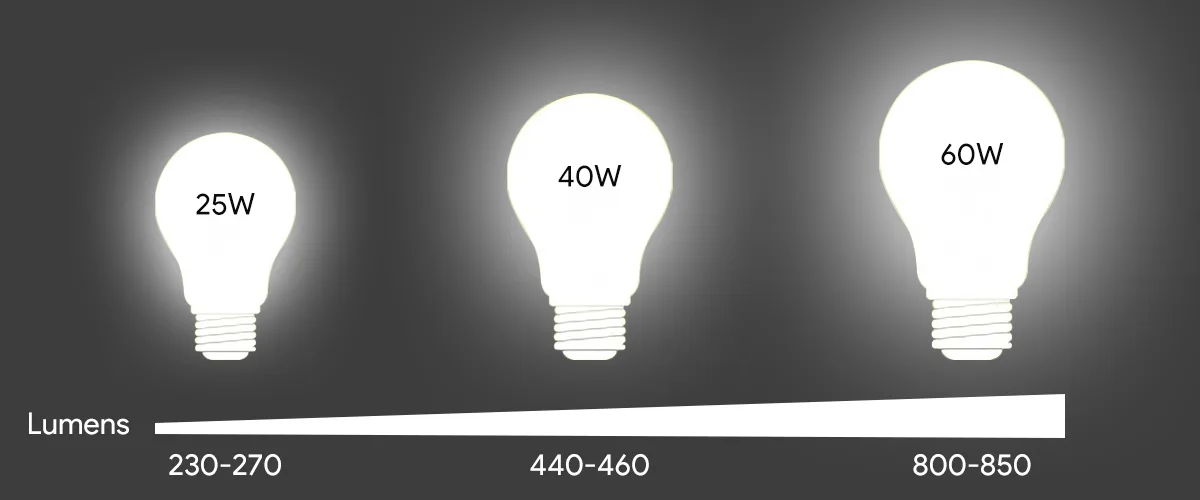
루멘은 모든 방향에서 광원의 총 광원 출력 또는 램프가 "방출"할 수 있는 광원을 나타냅니다. 따라서 조명 매개변수를 이해할 때 루멘은 종종 가장 직관적이고 일반적인 지표입니다.
예를 들어, 800루멘으로 표시된 LED 전구는 기존의 60와트 백열 전구와 동일한 광 출력을 제공할 수 있음을 의미합니다. 이 값은 조명 기구를 구입할 때 조명 기구를 구입할 때 조명 장치 자체의 고유한 속성이며 설치 환경과 무관하기 때문에 다양한 제품의 밝기를 빠르게 비교할 수 있도록 도와줍니다.
루멘은 광원의 잠재적 출력을 측정하는 데 더 적합하지만 실제 환경에서 빛의 영향을 직접적으로 나타낼 수는 없습니다. 즉, 두 개의 조명이 같은 루멘 값을 가지고 있더라도 시각적 밝기는 공간마다 또는 설치 방법이 다르면 완전히 다를 수 있습니다.
관련 독서:
켈빈과 루멘의 차이점 이해하기
내 공간에 몇 루멘이 필요합니까?
럭스는 무엇입니까?
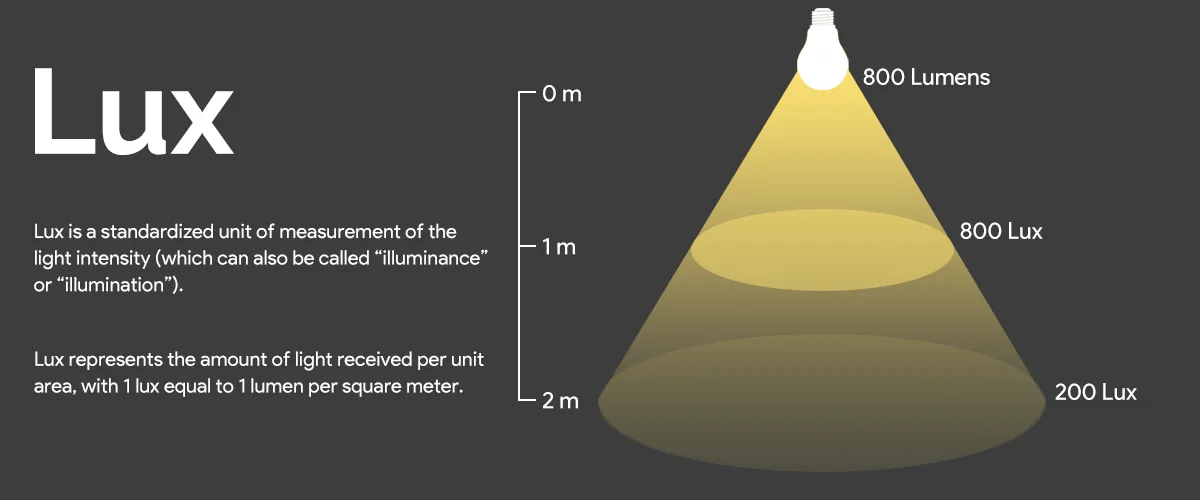
럭스는 단위 면적당 수신된 빛의 양을 나타내며, 1lux는 평방 미터당 1루멘과 같습니다. Lux는 조명 품질을 평가하기 위한 핵심 지표입니다. 왜냐하면 궁극적으로 인간의 눈의 경험을 결정하는 것은 조명기가 얼마나 많은 빛을 방출하는지가 아니라 실제로 우리 활동 영역에 도달했을 때 그 빛의 강도이기 때문입니다. 대조적으로 Lux(Lux)는 사용자의 실제 경험과 더 밀접하게 일치합니다.
Lux는 광원 자체를 측정하지 않고 책상, 주방 조리대 또는 진열장과 같이 실제로 표면을 비추는 빛의 양을 측정합니다. 룩스는 특정 영역에 루멘이 분포되어 있는 결과로 이해할 수 있으므로 공간이 충분히 밝은지 여부를 보다 직관적으로 측정할 수 있습니다.
더 중요한 것은 Lux가 거리와 직접적인 관계가 있다는 것입니다. 광원이 표면에 가까울수록 단위 면적당 광도가 더 집중되어 lux 값이 높아지며, 반대로 광원이 더 멀리 떨어져 있으면 동일한 루멘이 더 넓은 영역에 분포되어 lux 값이 크게 감소합니다.
이것은 실제 사례에서 쉽게 관찰할 수 있습니다. 책상에서 1m 떨어진 곳에 1,000루멘의 조명이 있으면 수백 lux를 얻을 수 있지만 3-4m 높이의 천장에 설치하면 책상의 조도가 급격히 감소합니다.
루멘과 럭스의 차이점
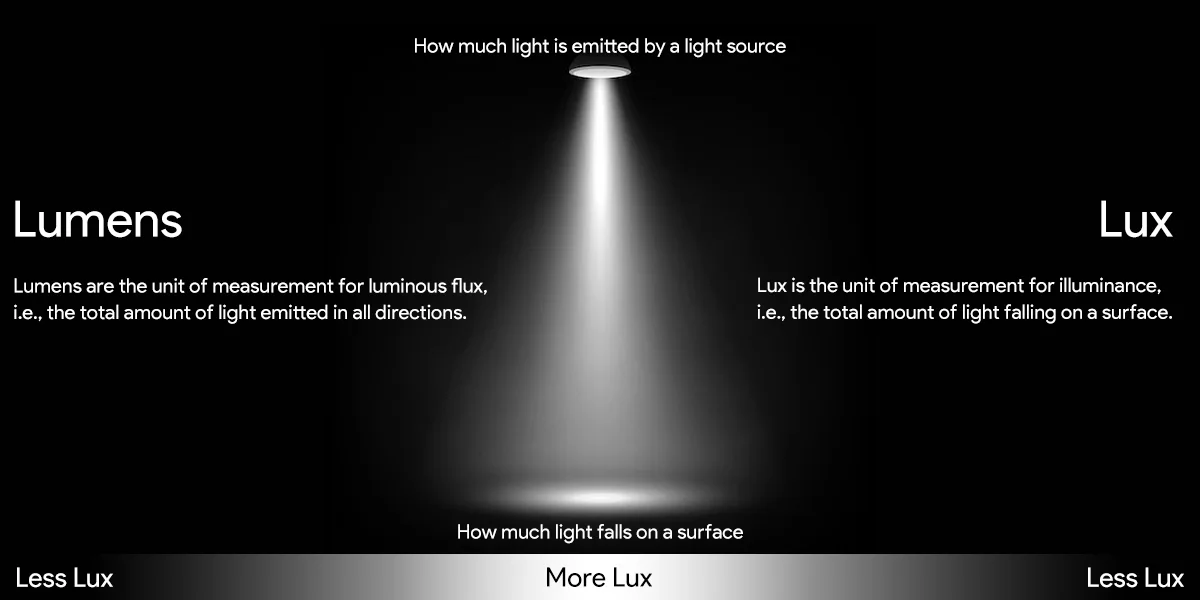
루멘과 럭스의 핵심 차이점은 다음과 같이 요약할 수 있습니다.
- 루멘은 발광 플럭스, 즉 모든 방향으로 방출되는 총 빛의 양에 대한 측정 단위입니다.
- lux는 조도의 측정 단위, 즉 표면에 떨어지는 총 빛의 양입니다.
루멘은 항상 일정하지만 럭스는 거리와 공간의 크기에 따라 다릅니다. 이러한 이유로 조명기구의 루멘만으로도 충분히 조명이 있는 공간이 있는지 판단할 수 없으며, 평가를 위해 럭스도 고려해야 한다.
이 두 가지 정의에서 루멘과 럭스는 상호 배타적인 개념이 아니라 다른 관점에서 빛을 설명한다는 것이 분명합니다. 전자는 광원이 방출할 수 있는 광원의 양을 알려주는 반면 후자는 특정 환경에서 인간의 눈이 얼마나 많은 빛을 감지할 수 있는지 알려줍니다. 두 가지를 결합해야만 특정 응용 시나리오에 조명 기구가 실제로 적합한지 과학적으로 결정할 수 있습니다.
루멘과 럭스의 차이와 연결
이전 섹션에서 우리는 루멘과 Lux의 정의와 핵심 차이점을 소개했지만 실제 응용 프로그램에서는 종종 혼동됩니다. 근본적인 차이점은 루멘이 LED 광원 자체의 총 출력에 초점을 맞추는 반면 Lux는 이 빛이 특정 공간이나 표면에 어떻게 분포되어 있는지에 초점을 맞추고 있다는 사실에 있습니다.
루멘은 "수전의 유량"으로 생각할 수 있으며, 럭스는 물이 땅에 닿을 때 형성되는 수층의 두께입니다. 같은 유속으로 작은 용기에 떨어지면 깊은 물이 발생하지만 넓은 지역에 퍼지면 얇아 보일 것입니다.
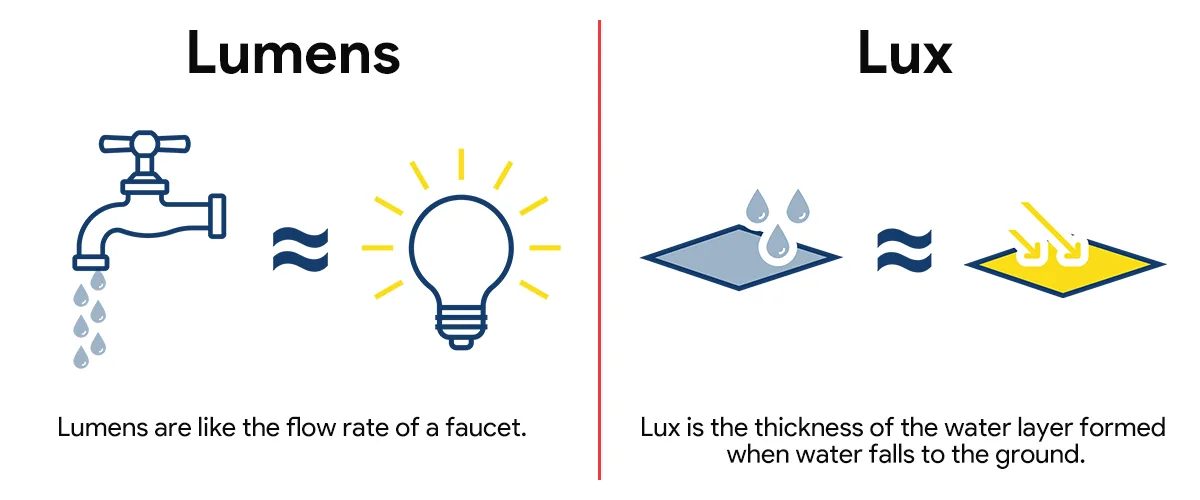
마찬가지로, 조명의 루멘 등급이 높더라도 천장이 매우 높은 천장에 설치되거나 광원 범위가 넓은 경우 작업 영역의 Lux가 여전히 부족할 수 있습니다.
이 구분은 또한 공식으로 직관적으로 표현할 수 있습니다.
럭스 = 루멘/면적
즉, 조도(lux)는 광원의 총 광출력(루멘)을 조명하는 영역으로 나눈 값과 같습니다. 이것은 또한 동일한 조명기구가 다른 환경에서 매우 다른 느낌을 줄 수 있는 이유를 설명합니다. 예를 들어, 1,000루멘으로 평가된 조명기구는 작은 방에서는 매우 밝게 느껴지지만 큰 홀에서는 어둡게 느껴질 수 있습니다. 전구의 루멘 값이 변했기 때문이 아니라, lux 값이 면적이 증가함에 따라 감소하기 때문입니다.
반면에 Lux는 광원과 대상 표면 사이의 거리와도 밀접한 관련이 있습니다. 거리가 멀어질수록 빛이 더 넓게 퍼져서 단위 면적당 받는 빛의 양이 줄어들고 lux 값이 감소합니다. 그러나 광원에서 방출되는 총 광량이 변하지 않았기 때문에 루멘은 일정하게 유지됩니다. 루멘은 빛의 "잠재력"을 결정하고 럭스는 실제 환경에서 "성능"을 결정합니다.
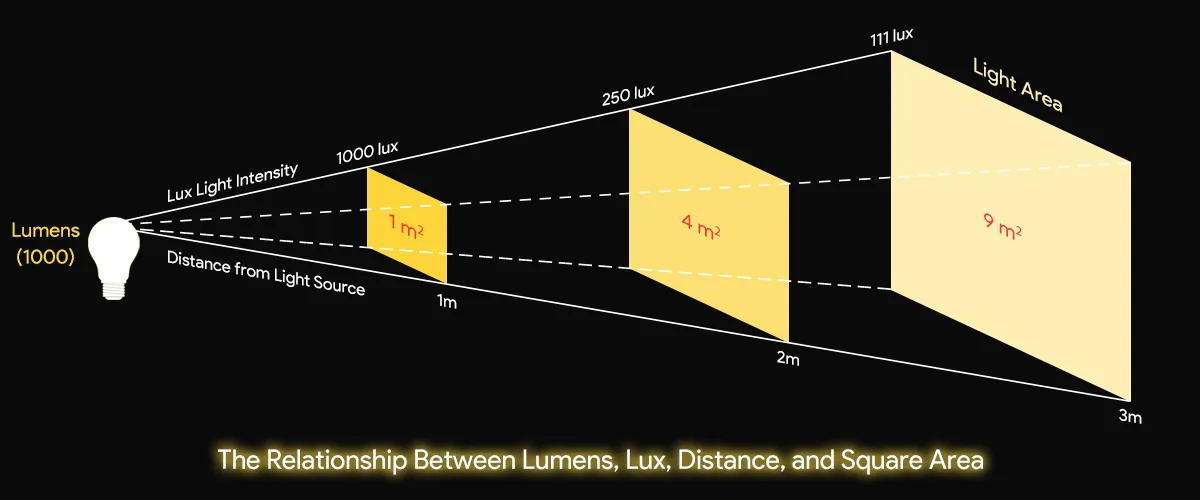
따라서 루멘과 럭스는 고립된 것이 아니라 보완적인 개념입니다. 루멘은 공급측에서 LED 조명기의 광 출력 기능을 이해하는 데 도움이 되며, Lux는 수요 측면에서 환경의 실제 조명 효과를 평가할 수 있게 해줍니다.
루멘만을 고려하면 넓은 공간에서 조명이 부족하다고 느낄 수 있으며, LED 픽스처의 고유 출력 기능을 무시하면서 럭스만 고려하면 선택하는 동안 픽스처의 적합성을 과소평가할 수 있습니다. 따라서 실제 조명 설계 및 LED 고정 장치 선택에서 이 두 가지 메트릭은 포괄적이고 정확한 평가를 달성하기 위해 함께 사용되어야 합니다.
루멘은 언제 사용해야 하나요? 언제 여 자가럭스에 집중하시나요?
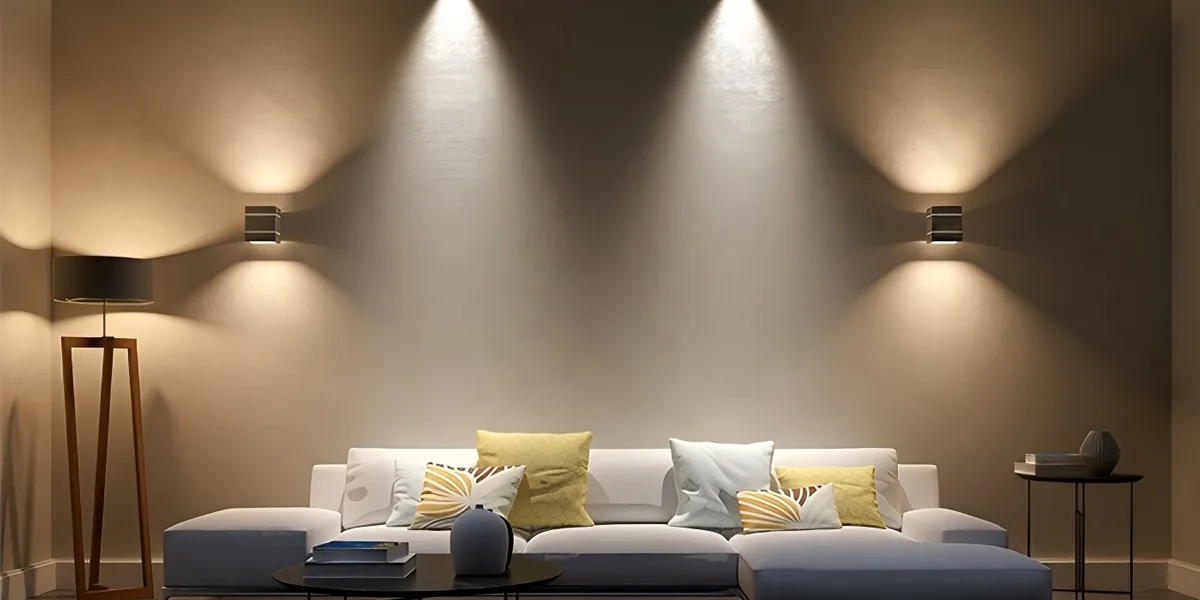
루멘과 럭스의 차이점과 연결을 이해한 후 공통 질문이 생깁니다. 다양한 상황에서 어떤 척도에 초점을 맞춰야 할까요?
루멘은 수평 비교에 적합하며, 럭스는 상세한 조명 설계를 수행할 때 초점을 맞춰야 하는 미터법입니다. 반면에 루멘은 단일 광원이 방출하는 빛의 양을 이해하는 데 매우 중요합니다. 이것은 전구의 총 광 출력을 비교하는 데 유용하지만 조명이 공간이나 작업에 대해 "충분한"지 여부를 결정할 수 없습니다.
따라서 각자에 대한 적절한 시나리오를 이해해야만 조명 선택의 효율성과 정밀도를 모두 달성할 수 있습니다.
조명기구의 전반적인 밝기를 이해하고 싶을 때 루멘은 가장 직접적인 기준입니다. 예를 들어, LED 전구를 선택할 때 소비자는 일반적으로 루멘 등급을 비교하여 기존의 40W, 60W 또는 100W 백열 전구를 대체할 수 있는지 여부를 결정합니다. 이러한 경우 루멘은 빠른 비교 벤치마크를 제공합니다. 따라서 소매 설정 또는 제품 비교에서 Lumens는 필수 메트릭입니다.
그러나 특정 영역이 충분히 밝은지 여부에 대해 우려한다면 Lux가 더 의미 있는 참조입니다. Lux는 조명 작업 표면의 실제 조도를 측정하므로 인간 활동과 가장 직접적으로 관련된 미터법입니다. 결국, 인간의 눈은 광원에 의해 방출되는 총 빛의 양을 인식하지 못하고 오히려 책상, 책 또는 작업대와 같은 표면에 떨어지는 빛의 조도를 인식합니다.
예를 들어, 독서 공간을 설계할 때 책상에 편안함과 눈 보호를 보장하기 위해 충분한 럭스가 있는지 확인해야 합니다. 주방 카운터 조명 디자인에서는 lux 값이 조리 과정의 안전성을 직접적으로 결정하며, 사진, 디스플레이 또는 실험실 환경에서 조명이 전문 표준을 충족하는지 여부를 평가하는 핵심 척도입니다.
다음은 몇 가지 일반적인 Lux 수준입니다.
| 에스원기 | LUX V알라하의 뜻 |
| 맑은 밤(달 없음) | 0.002 1x |
| 맑은 밤(보름달) | 0.27-1 LX |
| 가족 거실 | 50lx |
| 일출/일몰 | 300-500 LX |
| 습격일 | 1000 LX |
| Daylight | 10,000-25,000 LX |
| 직사광선 | 32,000-130,000 LX |
루멘 및 럭스 측정 도구 및 방법
루멘과 럭스의 개념을 이해한 후 또 다른 일반적인 질문은 이러한 값이 어떻게 측정됩니까? 측정 방법 측면에서 둘 사이에는 상당한 차이가 있습니다.
루멘을 측정하는 것은 훨씬 더 복잡합니다. 광원이 모든 방향으로 방출하는 총 광속을 나타내므로 정확한 값을 얻으려면 등기구를 특수 장치에 배치해야 합니다.
일반적으로 사용되는 도구는 구 또는 IES 분포 광도계를 통합하는 것입니다. 이러한 장치는 광원에서 방출되는 모든 빛을 균일하게 수집하고 반사한 다음 전문 센서 및 해당 광학 계산 시스템을 사용하여 전체 루멘 값을 계산합니다.

이 측정 과정은 특수 장비와 엄격한 실험 환경을 필요로 하기 때문에, 일반적으로 LED 조명 제조업체 또는 실험실에서 루멘을 제공하며, 소비자는 이를 측정하는 경우가 거의 없습니다.
럭스 측정은 비교적 간단합니다. 럭스는 특정 표면의 조도에 초점을 맞추므로 측정 장치만 대상 위치에 배치하면 됩니다.
일반적인 도구에는 해당 지점에서 Lux 값을 직접 표시할 수 있는 휴대용 광도계가 포함됩니다. 이를 통해 일반 사용자는 집이나 사무실 환경에서 조명이 적절한지 빠르게 평가할 수 있습니다. 이 방법의 편리함은 Lux를 실제 적용에서 직접 평가하기가 더 쉬워지므로 조명 표준으로 널리 사용됩니다.
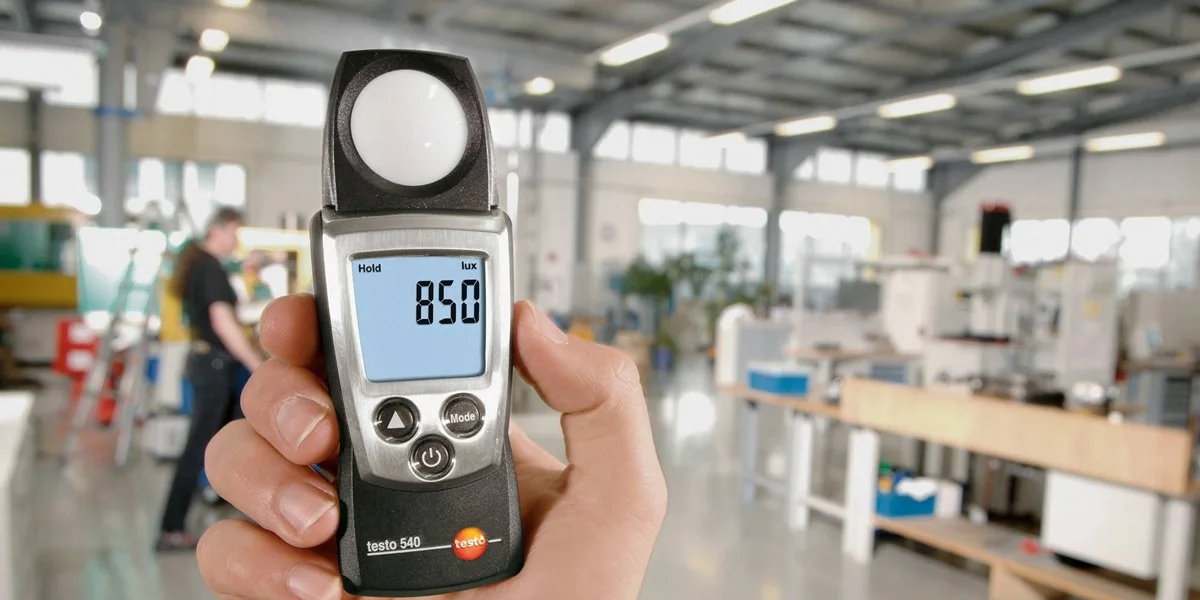
Lux 측정은 일상 생활과 더 밀접하게 일치하여 사용자와 디자이너가 실제 시나리오에서 조명 효과를 확인하는 데 편리한 반면 루멘 측정은 전문적인 방법에 더 의존하고 제품 성능 테스트 및 비교를 위한 중요한 기반이 됩니다. 이 차이는 Lux와 Lumens가 개념적으로 밀접하게 관련되어 있지만 실제 운영 및 적용에서의 역할은 완전히 구별된다는 것을 다시 한 번 강조합니다.
실용적인 응용 분야에서 Lux: 다양한 공간에 권장되는 조도 수준
Lux의 가치를 진정으로 이해하려면 특정 공간과 작업의 맥락에서 고려해야 합니다. 다양한 주거 또는 작업 환경에는 조도 수준에 대한 요구 사항이 다릅니다.
집이나 레스토랑과 같은 장소에 대한 일반적인 권장 사항이 있지만 특정 위치에는 특정 럭스 수준이 필요할 수 있습니다. 예를 들어 다음 목록은 특정 특성을 가진 위치에 필요한 조도 값을 보여줍니다.
| 특별한 위치 | 럭스 V알라하의 뜻 |
| 주방(작업 공간) | 500–600 LX |
| 주방(일반 공간) | 200–300 LX |
| 침실(헤드보드 또는 독서 공간) | 500파운드 |
| 침실(일반 공간) | 100–200 LX |
| 어린이실(놀이 공간) | 300lx |
| 거실(일반 공간) | 200–300 LX |
| 거실(TV 공간) | 50lx |
| 공부/독서실 | 500파운드 |
| 욕실(일반 공간) | 200파운드 |
| 욕실(거울 영역) | 300–500 LX |
| 복도(복도 또는 계단) | 100–200 LX |
| 워크샵 | 150-500 LX |
| 사무용 책상 | 500-750 LX |
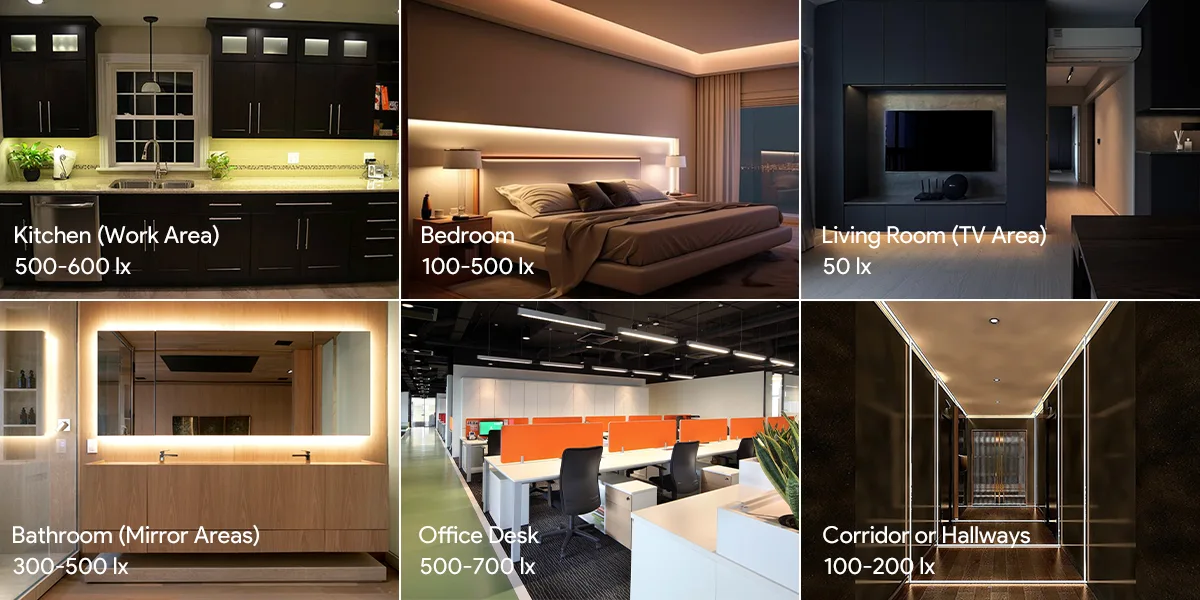
이러한 값은 조명 기구를 선택할 때 적합성을 결정하기 위해 루멘에만 의존할 수 없음을 상기시킵니다. 루멘은 조명기 자체에서 출력되는 광량을 나타내지만 실제 요구 사항을 충족하는지 여부는 공간 영역 및 사용 작업을 기반으로 필요한 럭스를 계산하는 데 달려 있습니다.
예를 들어, 10제곱미터의 판독 영역에 500 lux의 조명을 제공하는 것이 목표인 경우에는 총 약 5,000루멘의 광원이 해당 지역에 분포되어야 하지만, 2,000루멘의 광원만 사용하는 경우에도 "밝게" 매개변수가 나타나더라도 최종 효과는 여전히 충분하지 않을 수 있습니다.
따라서 Lux는 더 명확한 사용 지침을 제공하는 반면 루멘은 조명 기구를 선택하기 위한 기본 데이터를 제공합니다. 두 가지를 결합하면 LED 조명 시스템의 과학적이고 합리적인 구성이 가능하여 각 공간이 편안하고 효율적입니다.
요약
LED 조명 분야에서 루멘과 럭스는 자주 언급되지만 종종 혼동되는 두 가지 개념입니다. 앞서 설명한 바와 같이 루멘은 조명의 전체적인 출력을 나타내며, 조명기의 잠재적인 밝기에 대한 미터법으로 사용되며, 룩스는 특정 표면이나 특정 공간에서의 빛의 분포를 측정하여 일상적인 사용에서 우리의 실제 경험과 더 밀접하게 일치합니다. 두 개념은 뚜렷한 차이점이 있지만 밀접하게 상호 연결되어 있습니다.
실제 적용 분야에서 루멘은 다양한 조명기구의 출력 기능을 비교하는 데 더 적합하여 제품을 선택할 때 "이 조명이 얼마나 밝은지"를 빠르게 평가하는 데 도움이 되며, 반면에 Lux는 작업 조명과 직접 연결되어 거울 앞에서 화장을 하는 동안 편안함, 주방 안전 및 선명도와 같은 요소를 결정합니다. 이러한 구분을 이해하면 조명을 계획할 때 보다 과학적으로 정보에 입각한 결정을 내리는 데 도움이 될 수 있습니다.
더 중요한 것은 조명 환경의 품질이 단일 숫자 값에 의해 결정되지 않는다는 것입니다. 진정으로 합리적인 조명 설계는 루멘의 공급과 Lux에 대한 수요를 동시에 고려해야 하며, 빛이 필요한 곳에 적절하게 분배되는 동시에 충분한 출력을 보장해야 합니다. 그래야만 공간이 효율적이고 편안하며 사람들의 사용 습관과 일치할 수 있습니다.
고품질 LED 조명 솔루션을 찾고 계십니까? SignLiteled는 14년 이상의 전문적인 경험을 가지고 있으며 LED 스트립 조명, LED 사인 튜브, LED 선형 조명, 그리고 LED 트라이프루프 조명. 우리는 귀하의 개인화 된 요구 사항을 충족하기 위해 안정적이고 에너지 효율적이며 맞춤형 제품을 제공합니다. 혁신적인 조명 솔루션을 탐색하고 프로젝트를 향상시키려면 지금 저희에게 연락하십시오.
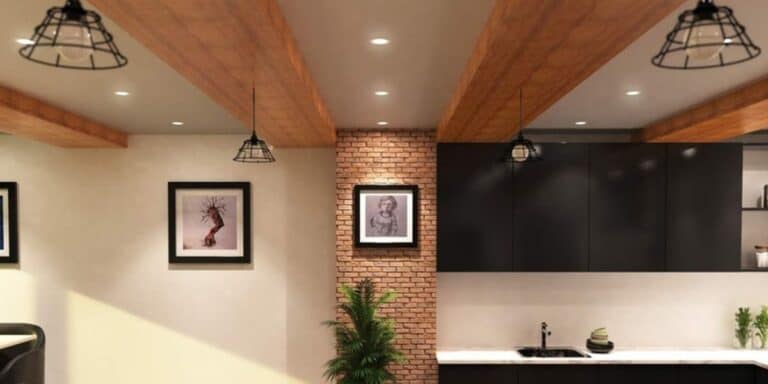

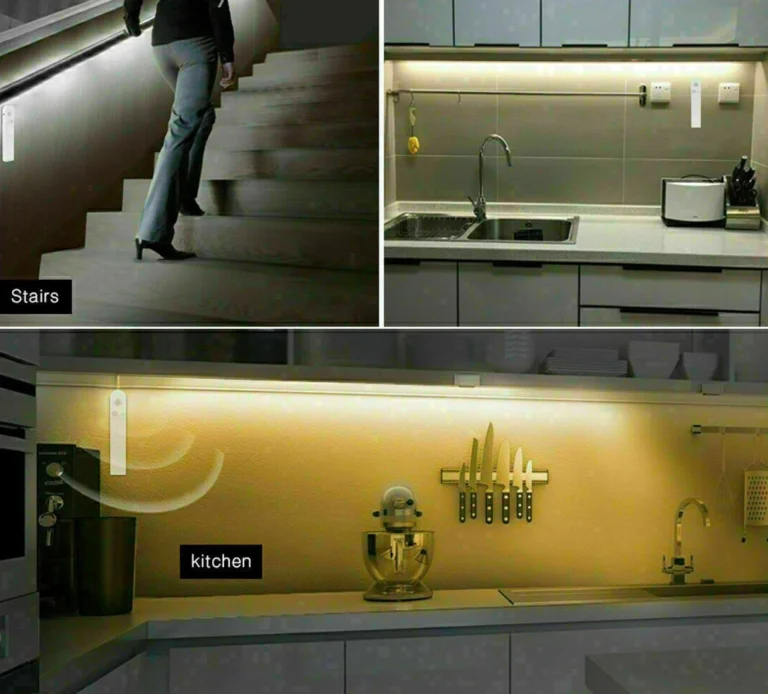
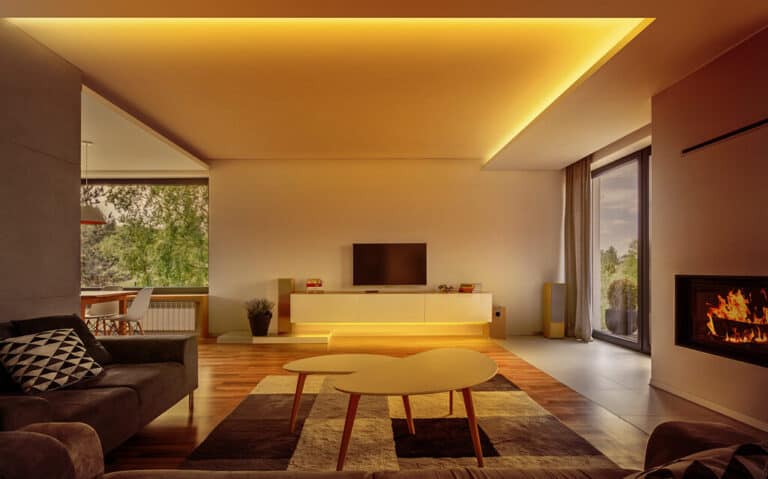

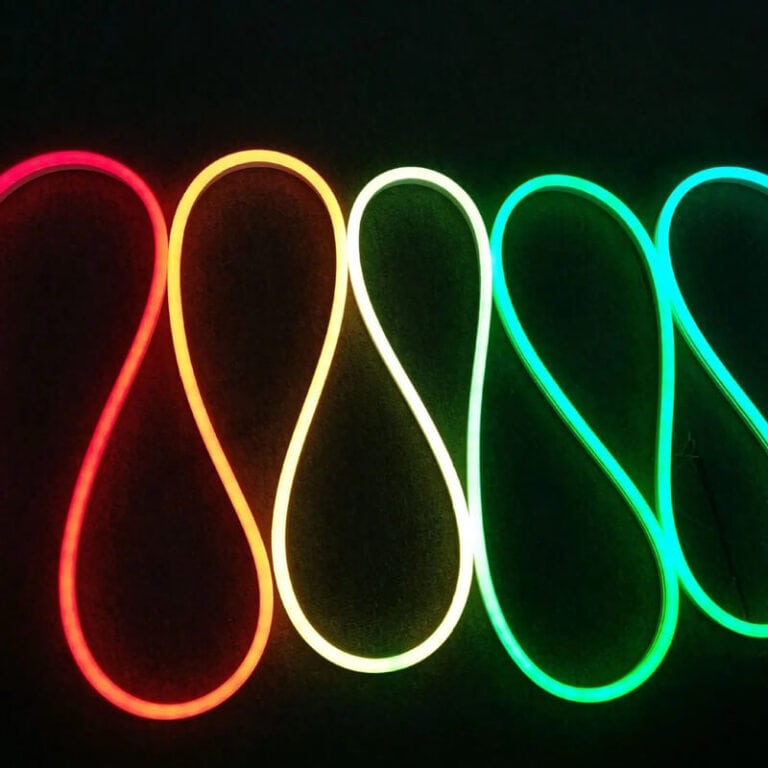

귀하의 블로그는 저에게 없어서는 안될 리소스가 되었습니다. 나는 당신이 제공해야 하는 새로운 통찰력을 항상 기대하고 있습니다. 꾸준히 최고 수준의 콘텐츠를 제공해주셔서 감사합니다!
내가 깨닫지 못하는 것은 사실 당신이 지금보다 훨씬 더 잘 지지하지 않는다는 것입니다. 당신은 지금 당신이 훨씬 더 멋져요 당신이 지금 매우 지적인 당신이 인식하는 이 주제와 관련하여 상당히 많이 인식하게 만들었습니다.
나는 당신이 당신의 게시물에 대해 제시한 모든 아이디어가 정말 설득력 있고 확실히 작동할 것이라고 믿습니다. 그럼에도 불구하고 게시물은 초보자에게 너무 짧습니다.
보통 나는 블로그에서 기사를 읽지 않지만 이 글이 나를 살펴보고 그렇게해야한다고 말하고 싶습니다. 그래서 당신의 글 취향이 나를 놀라게했습니다. 감사합니다.